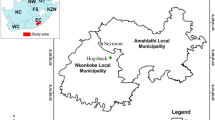Summary
Investigations were conducted on the identification and distribution of yam natural pollinators, flowering pattern and hybridization of white yam (Dioscorea rotundata Poir.) at the International Institute of Tropical Agriculture (IITA), Ibadan, Nigeria, in order to provide informations for producing hybrid seeds needed for vam genetic improvement.
Insects belonging to the Coleoptera (48.0%), Diptera (20.4%), Hymenoptera (20.0%), Hemiptera (5.8%), and Thysanoptera (5.8%) were caught around yam plants and presumed to be pollinators: they entered open-receptive-flowers and their presence on yam plants coincided with the duration of the flowering period.
Studies on the flowering pattern revealed that: (i) Male and female clones differed in their periods of flower initiation as well as the flowering duration; (ii) Seed production and conventional breeding methods are feasible if staggered planting, water and soil fertility could be managed to ensure that flowering periods of males and females nick and also extend flowering.
Artificial pollinations within white yam and between white yam and yellow yam (D. cayenensis Lam) using the camel hair brush method were successful, but resulted in a relatively low fruit set (31.8% maximum). This method was more effective than natural pollination (19.2%) and can thus supplement it for the production of hybrid seeds for introducing genetic variation in yam breeding populations.
Similar content being viewed by others
References
Akoroda, M.O., 1981. Studies on the genetics and floral biology of yams (Dioscorea rotundata Poir, and D. cayenensis Lam.). Ph.D. thesis, University of Ibadan, Nigeria, 298 pp.
Akoroda, M.O., 1983. Floral biology in relation to hand pollination of white yam. Euphytica 32: 831–838.
Akoroda, M.O., 1985. Pollen Management for controlled hybridization of white yam. Scientia Hortic. 25: 201–209.
IITA, 1974. 1974 Annual Report. IITA, Ibadan, Nigeria.
Martin, F.W., 1966. Sex ratio and sex determination in Dioscorea. J. Hered. 57: 95–99.
Okoli, O.O., 1975. Yam production from seeds: Prospects and problems. Paper presented at the 11th Conference of the Agricultural Society of Nigeria, Enugu, Nigeria, July 1–15, 1975.
Okoli, O.O., 1981. Parameters for selecting parents for yam hybridization. In: E.R. Terry, K.A. Oduro & F. Caveness (Eds), Tropical Root Crops: Research Strategies for the 1980's. Proceedings of the first triennal symposium of the International Society for Tropical Root Crops (Africa Branch), Ibadan, Nigeria, 1981. pp. 163–165.
Pitkin, B.R., 1973. Larothrips dentipes (Thysanoptera, Thripidae), a new genus and species of Thrips from yam flowers in Nigeria. Bull. Entomol. Res. 62: 415–418.
Sadik, S. & O.U. Okereke, 1975a. A new approach to improvement of yam Dioscorea rotundata. Nature 254: 134–135.
Sadik, S. & O.U. Okereke, 1975b. Flowering, pollen grain germination, fruiting, seed germination and seedling development of white yam, Dioscorea rotundata Poir. Ann. Bot. 34: 597–604.
Author information
Authors and Affiliations
Rights and permissions
About this article
Cite this article
Segnou, Fatokun, C.A., Akoroda, M.O. et al. Studies on the reproductive biology of white yam (Dioscorea rotundata Poir.). Euphytica 64, 197–203 (1992). https://doi.org/10.1007/BF00046049
Received:
Accepted:
Issue Date:
DOI: https://doi.org/10.1007/BF00046049




